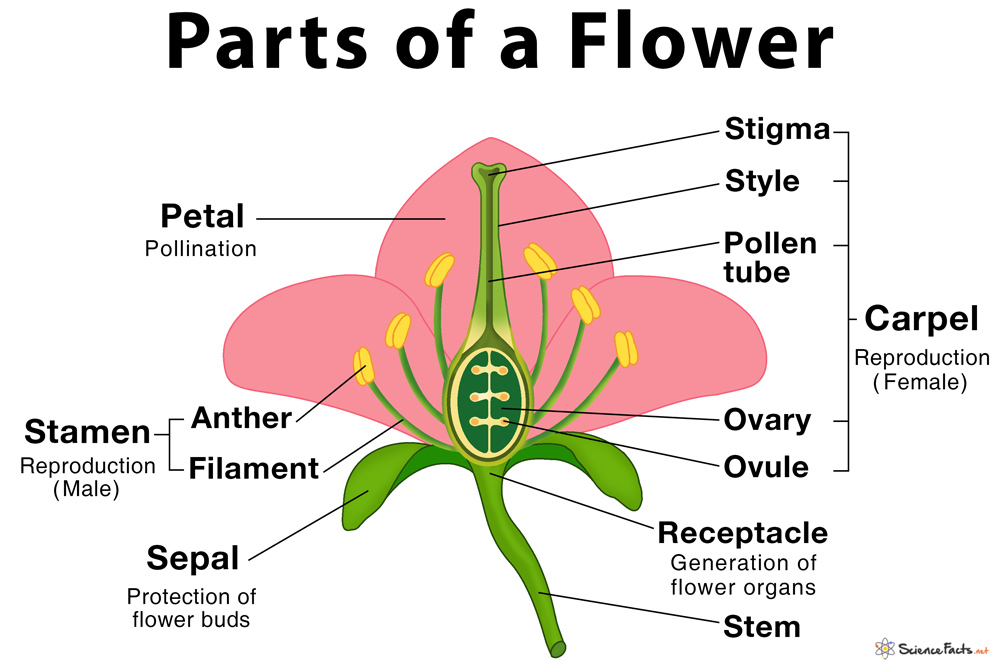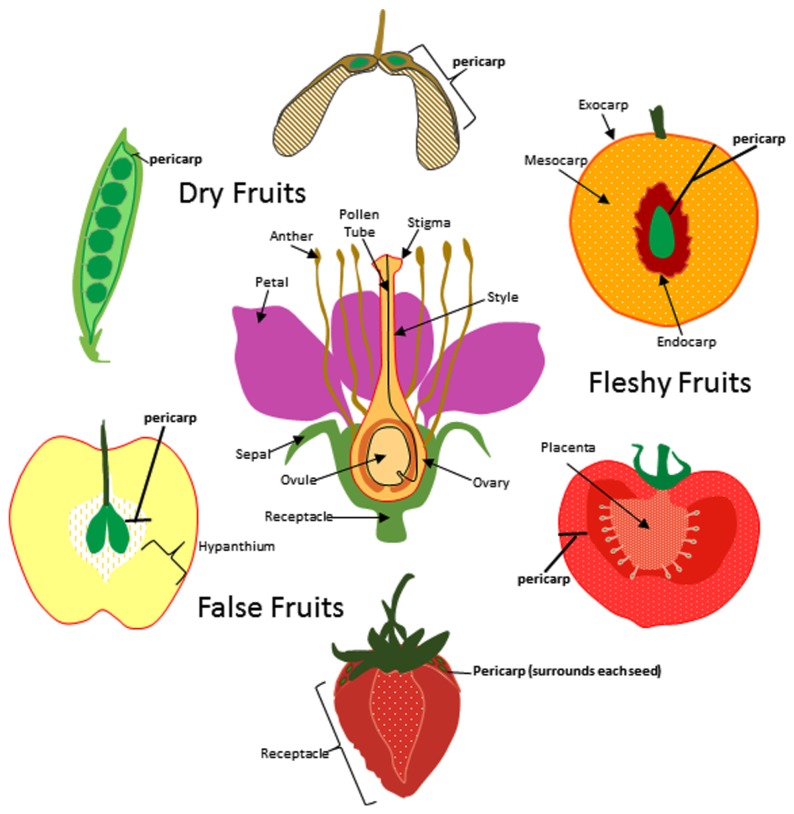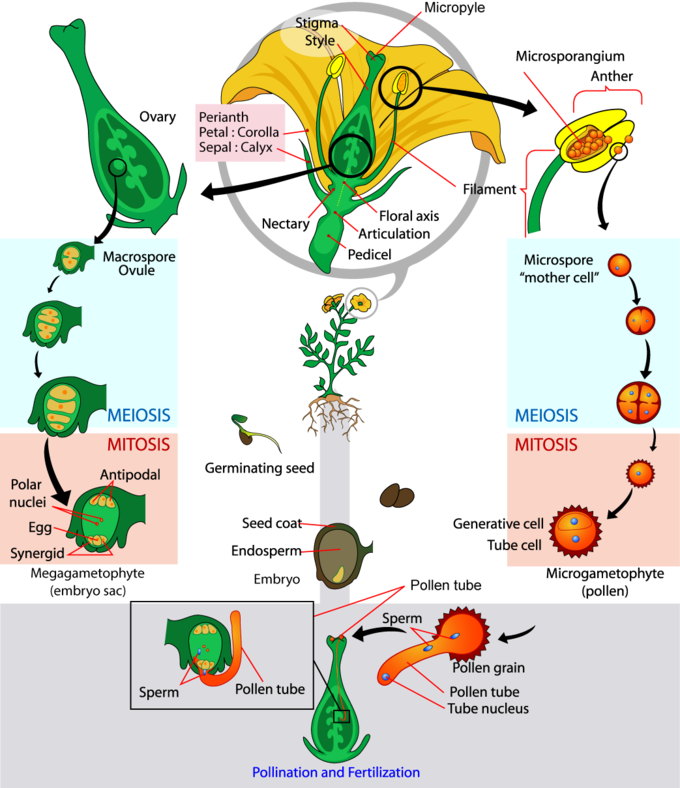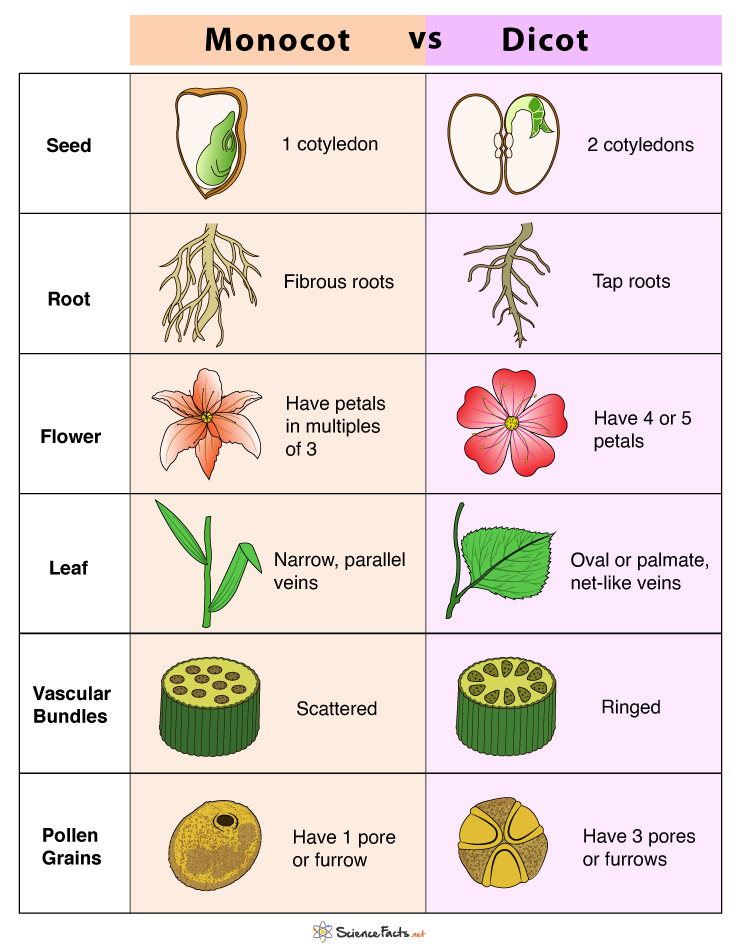Angiosperms Study Guide
Introduction:
Flowers and fruit are two unique reproductive systems responsible for angiosperms’ success. The flower’s purpose is to ensure pollination. Flowers also shield the developing embryo and ovule inside the receptacle. The fruit’s purpose is to disperse seeds. They also safeguard the growing seed.
Different Types of Angiosperms
Flower:
- Flowers are sporophylls, which are modified leaves arranged around a central stem.
- Despite their differences in appearance, flowers have the same structures: sepals, petals, carpels, and stamens. The peduncle is the stalk that connects the flower to the plant.
- At the foot of the peduncle, a whorl of sepals (collectively known as the calyx) encloses the unopened flower bud. Photosynthetic organs are commonly found in sepals.
- Petals, which make up the corolla, are found within the whorl of sepals and are frequently brightly colored to attract pollinators.
- The perianth is made up of sepals and petals. The flower’s sexual organs (carpels and stamens) are found in the center.
- The thick tissues of the carpel develop and protect the megaspores and female gametophytes.
- The sticky stigma, where pollen is deposited, is connected to the ovary, which is encased in the carpel by a long, thin structure called a style.
- One or more ovules reside in the ovary, each of which will develop into a seed once fertilized.
- The stamens (also known as the androecium) are the male reproductive organs that surround the central carpel.
- Stamens are made up of a filament, which is a slender stalk, and an anther, which is a sac-like structure. The filament supports the anther, where meiosis produces microspores, which grow into pollen grains.
Fruits:
- The ovary’s walls thicken as the seed matures, forming the fruit. The seed develops in an ovary, which grows in size as the seeds mature.
- Fruit is a fertilized, fully formed, ripened ovary in botany. Many plants usually referred to as veggies are actually fruits.
- Fruit that has reached maturity might be luscious or dry. Berries, peaches, apples, grapes, and tomatoes are examples of fleshy fruit. Dry fruit includes things like rice, wheat, and nuts.
- The ovary does not produce all fruits. Strawberries, for example, come from the receptacle, while apples come from the pericarp or hypanthium.
- Herbivores are attracted to some fruits because of their color or scent or because they provide food. Tough, undigested seeds are spread via the herbivore’s feces once consumed. Burs and hooks on other fruits let them cling to hair and hitch rides on animals.
Fertilization:
- One egg cell, two synergids or “helper” cells, three antipodal cells, and two polar nuclei in a central cell make up the complete embryo sac.
- When a pollen grain reaches the stigma, a pollen tube emerges from the grain, grows down the style, and enters the ovule through the micropyle, which is an opening in the integuments. In the embryo sac, the two sperm cells are placed.
- After that, there is a twofold fertilization event. A diploid zygote—the future embryo—is formed when one sperm and one egg unite.
- The other sperm combines with the 2n polar nuclei to generate a triploid cell that will grow into endosperm, a food reserve tissue.
- The zygote matures into an embryo with a radicle, or tiny root, and one (monocot) or two (dicot) cotyledons, which are leaf-like structures.
- The seed coat is made up of a hardened layer of integuments, the endosperm containing food stores, and the well-protected embryo in the core.
- Only a few species self-pollinate; most blooms are monoecious or bisexual, meaning they have both stamens and carpels. Because they include both sex organs, monoecious flowers are often known as “perfect” blooms.
- Cross-pollination boosts a species’ genetic diversity.
Monocots:
- A single cotyledon in the seedling is the most common way to identify monocot plants.
- Parallel venation in leaves and flower components that are organized in a three- or six-fold symmetry is a further anatomical trait shared by monocots.
- True woody tissues are rarely found in monocots.
Dicots:
- The presence of two cotyledons in the growing shoot distinguishes dicots.
- In leaves, veins create a network, and flower parts are divided into four, five, or more whorls.
- In dicots, vascular tissue forms a ring around the stem, but the vascular tissue is dispersed throughout the stem in monocots. Eudicots generate either herbaceous (like grasses) or woody tissues.
Conclusion:
- Flowers and fruit, two unique reproductive systems, are responsible for angiosperms’ success.
- The flower’s purpose is to ensure pollination. Flowers also shield the developing embryo and ovule inside the receptacle.
- The fruit’s purpose is to disperse seeds, and they also safeguard the growing seed.
- Flowers are sporophylls, which are modified leaves arranged around a central stem.
- The ovary’s walls thicken as the seed matures, forming the fruit. The seed develops in an ovary, which grows in size as the seeds mature.
FAQs:
1. What is the difference between an angiosperm and a gymnosperm?
Plants are divided into two groups: angiosperms and gymnosperms. Flowering plants, often known as angiosperms, have seeds encased within their fruit. On the other hand, Gymnosperms have no flowers or fruits, only bare seeds on the surface of their leaves. The cones are made up of Gymnosperm seeds.
2. What is the simple definition of an angiosperm?
Angiosperms are flowering plants that generate seeds in the form of fruits. With almost 300,000 species, they are the biggest and most varied group within the kingdom Plantae. Angiosperms account for over 80% of all known live green plants.
3. What are five examples of angiosperms?
Roses, broccoli, petunias, tomato, sugarcane, rice, wheat are a few examples of angiosperms.
4. What are the 5 characteristics of angiosperms?
- Flower
- Endosperm within their seeds
- Formation of seeds-containing fruits
- Stems, roots, and leaves are all parts of the sporophyte.
- True vessels in the xylem and companion cells in the phloem make up the vascular system.
5. Why are angiosperms important to humans?
Angiosperms are an important food source for humans, including grains, sugars, vegetables, fruits, oils, nuts, and spices.
6. Which trees are angiosperms?
Angiosperms are trees with large leaves that change color in autumn and fall. Deciduous trees include oaks, maples, and dogwoods.
7. Do angiosperms produce pollen?
Angiosperms, like gymnosperms, are heterosporous. As a result, microspores are produced, which create pollen grains as male gametophytes, and megaspores are produced, which form an ovule with female gametophytes.
8. What makes angiosperms different from other plants?
The way angiosperms and gymnosperms grow their seeds is a major distinction. Angiosperm seeds form in the ovaries of flowers and are encased in a protective fruit.
9. Why are angiosperms the most dominant plants?
With higher photosynthesis, there was more carbon available for growth. Around 150 million years ago, this would have provided angiosperms the energy to drive competitors like conifers out of the canopy, making angiosperms the most prolific group of land plants on the planet.
We hope you enjoyed studying this lesson and learned something cool about Angiosperms! Join our Discord community to get any questions you may have answered and to engage with other students just like you! Don’t forget to download our App to experience our fun, VR classrooms – we promise, it makes studying much more fun! 😎
Sources:
- Life Cycle of Angiosperms. https://flexbooks.ck12.org/cbook/ck-12-biology-flexbook-2.0/section/9.21/primary/lesson/angiosperm-life-cycle-bio/ Accessed 9 Dec, 2021.
- Plant Life Cycles Study Guide. https://flexbooks.ck12.org/studyguides/biology/life-cycle-plant-life-cycles-study-guide.html?encodedID=SCI.BIO.654&courseContextID=5292077 Accessed 9 Dec, 2021.




